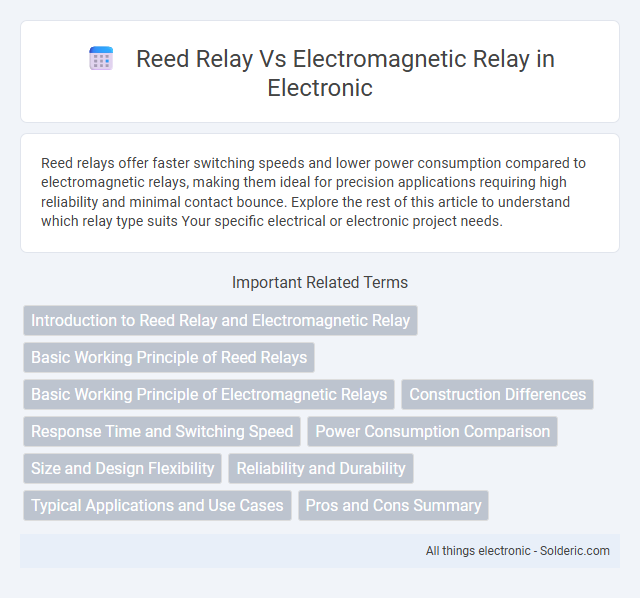Reed relays offer faster switching speeds and lower power consumption compared to electromagnetic relays, making them ideal for precision applications requiring high reliability and minimal contact bounce. Explore the rest of this article to understand which relay type suits Your specific electrical or electronic project needs.
Comparison Table
| Feature | Reed Relay | Electromagnetic Relay |
|---|---|---|
| Switching Mechanism | Magnetic reed contacts sealed in glass | Electromagnetic coil operates mechanical armature |
| Contact Type | Hermetically sealed contacts | Exposed mechanical contacts |
| Response Time | Fast (milliseconds) | Slower (tens of milliseconds) |
| Durability | High cycle life (millions of operations) | Lower cycle life due to mechanical wear |
| Contact Rating | Low current, low voltage applications | Handles higher current and voltage |
| Size | Compact and lightweight | Larger, heavier |
| Power Consumption | Low coil power | Higher coil power requirement |
| Switching Noise | Minimal electrical noise | Possible sparking and EMI noise |
| Applications | High-speed switching, sensitive instrumentation | Power switching, general automation |
Introduction to Reed Relay and Electromagnetic Relay
Reed relays use thin, magnetically sensitive metal reeds enclosed in a glass tube, offering fast switching speeds and low contact resistance ideal for precision applications. Electromagnetic relays rely on a coil-generated magnetic field to mechanically move contacts, supporting higher current loads and durability for industrial use. Understanding these differences helps you select the right relay type based on switching speed, sensitivity, and power requirements.
Basic Working Principle of Reed Relays
Reed relays operate by using a pair of ferromagnetic reeds sealed within a glass tube that close or open an electrical circuit when exposed to a magnetic field generated by an electromagnetic coil. Unlike standard electromagnetic relays that use an armature to make or break contacts, reed relays rely on the direct magnetic attraction of the reeds themselves, resulting in faster switching speeds and reduced contact bounce. This fundamental working principle makes reed relays ideal for applications requiring low signal interference and high-speed operation, such as telecommunications and test instruments.
Basic Working Principle of Electromagnetic Relays
Electromagnetic relays operate by using an electric current to generate a magnetic field, which actuates a movable armature to open or close contacts, enabling the switching of electrical circuits. When current flows through the coil, the magnetic field pulls the armature toward the coil, establishing or breaking the circuit connection. This simple electromechanical principle distinguishes electromagnetic relays from reed relays, which rely on magnetic reeds enclosed in a glass tube for switching.
Construction Differences
Reed relays consist of thin, ferromagnetic reeds sealed in a glass envelope, which act as contacts that close through magnetic attraction generated by a coil. Electromagnetic relays use an iron core electromagnet to mechanically move larger, separate contacts, often made of metal alloys, within a plastic or metal housing. Reed relays provide faster switching and longer life due to sealed contacts, while electromagnetic relays accommodate higher current loads with more robust construction.
Response Time and Switching Speed
Reed relays offer significantly faster response times, typically in the range of 0.5 to 2 milliseconds, compared to electromagnetic relays which usually operate between 5 to 20 milliseconds. Their swift switching speed makes reed relays ideal for high-frequency applications and precise signal control. Your choice of relay should consider these factors if rapid response and minimal signal delay are critical.
Power Consumption Comparison
Reed relays typically consume less power than electromagnetic relays due to their smaller coil size and lower operating current, making them ideal for battery-powered and energy-sensitive applications. Electromagnetic relays require higher current to energize their coils, resulting in increased power consumption, especially in continuous operation scenarios. Your choice should consider power constraints, with reed relays offering more energy-efficient switching for low-power devices.
Size and Design Flexibility
Reed relays offer a compact size and slim design, making them ideal for applications with space constraints or requiring high-density relay arrays. Electromagnetic relays tend to be bulkier due to their coil and armature mechanism, limiting design flexibility in compact or lightweight devices. Your choice between the two should consider the physical footprint and how it impacts the overall device design and integration.
Reliability and Durability
Reed relays offer superior reliability and durability due to their sealed contacts, which prevent contamination and reduce wear, making them ideal for low current and high-speed switching applications. Electromagnetic relays have mechanical contacts exposed to environmental factors, often resulting in quicker contact degradation and shorter lifespan under heavy-duty or high-load conditions. Your choice should consider reed relays for precision and longevity, while electromagnetic relays suit applications requiring higher current handling despite potential maintenance needs.
Typical Applications and Use Cases
Reed relays are commonly used in low-power, high-speed switching applications such as test equipment, telecommunications, and medical devices due to their fast response time and low contact capacitance. Electromagnetic relays find typical use in high-current switching tasks like industrial machinery, motor controls, and automotive systems, offering durability and the ability to handle larger loads. Both relay types serve critical roles in circuits where isolation and control are required, but their distinct characteristics make them suited to different environments and operational demands.
Pros and Cons Summary
Reed relays offer fast switching speeds, low contact resistance, and long operational life, making them ideal for delicate or high-frequency applications. Electromagnetic relays provide higher load capacity and better tolerance to voltage spikes but tend to suffer from slower response times and mechanical wear. Reed relays may be limited by lower power ratings and higher cost, while electromagnetic relays excel in robust, high-power switching environments despite bulkier size and noise generation.
Reed relay vs electromagnetic relay Infographic

 solderic.com
solderic.com